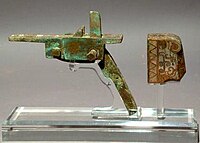
Photo from wikipedia
Airplane cabin ventilation is essential to ensure passengers' well-being. The conventional ventilation method is mixing ventilation with a statistically steady supply, which, according to former studies, has reached its limits… Click to show full abstract
Airplane cabin ventilation is essential to ensure passengers' well-being. The conventional ventilation method is mixing ventilation with a statistically steady supply, which, according to former studies, has reached its limits regarding, for example, the ventilation efficiency. However, the effect of a statistically unsteady (time-periodic) supply on the mixing ventilation efficiency has remained largely unexplored. This research uses computational fluid dynamics (CFD) with the large eddy simulation (LES) approach to study isothermal time-periodic mixing ventilation in a section of a single-aisle airplane cabin model, in which the air exhaled by the passengers functions as (passive) contaminants. Two time-periodic supply strategies are evaluated. The induced time-periodic airflow patterns promote an efficient delivery of fresh air to the passenger zone and affect the passengers' expiratory plumes. This results in increased mean contaminant mass fluxes, causing a strong reduction of the mean contaminant concentrations in the passenger zone (up to 23%) and an increased contaminant extraction from the cabin. Mean velocities increase with up to 55% but remain within the comfortable range. It is shown that the ventilation efficiency improves; that is, the contaminant removal effectiveness and air change efficiency (in the full cabin volume) increase with up to 20% and 7%, respectively.
Journal Title: Indoor air
Year Published: 2022
Link to full text (if available)
Share on Social Media: Sign Up to like & get
recommendations!